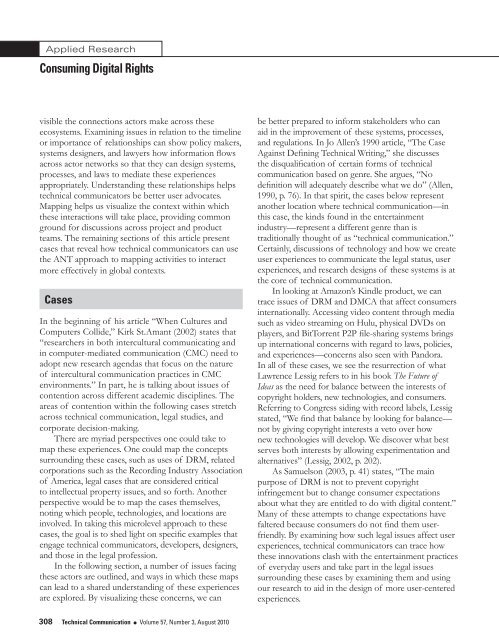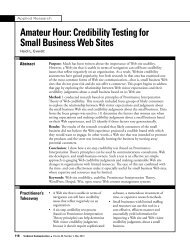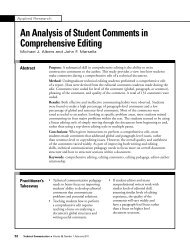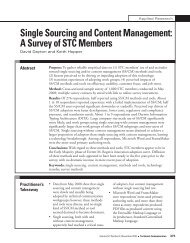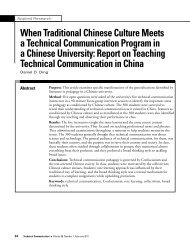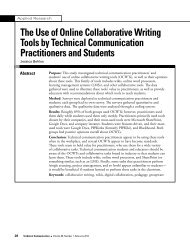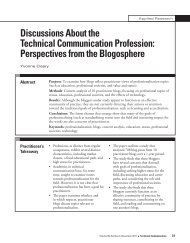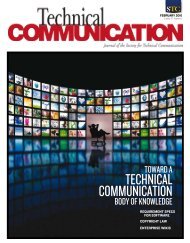Applied ResearchConsuming Digital Rightsvisible the connections actors make across theseecosystems. Examining issues in relation to the timelineor importance of relationships can show policy makers,systems designers, and lawyers how information flowsacross actor networks so that they can design systems,processes, and laws to mediate these experiencesappropriately. Understanding these relationships helpstechnical communicators be better user advocates.Mapping helps us visualize the context within whichthese interactions will take place, providing commonground for discussions across project and productteams. The remaining sections of this article presentcases that reveal how technical communicators can usethe ANT approach to mapping activities to interactmore effectively in global contexts.CasesIn the beginning of his article “When Cultures andComputers Collide,” Kirk St.Amant (2002) states that“researchers in both intercultural communicating andin computer-mediated communication (CMC) need toadopt new research agendas that focus on the natureof intercultural communication practices in CMCenvironments.” In part, he is talking about issues ofcontention across different academic disciplines. Theareas of contention within the following cases stretchacross technical communication, legal studies, andcorporate decision-making.There are myriad perspectives one could take tomap these experiences. One could map the conceptssurrounding these cases, such as uses of DRM, relatedcorporations such as the Recording Industry Associationof America, legal cases that are considered criticalto intellectual property issues, and so forth. Anotherperspective would be to map the cases themselves,noting which people, technologies, and locations areinvolved. In taking this microlevel approach to thesecases, the goal is to shed light on specific examples thatengage technical communicators, developers, designers,and those in the legal profession.In the following section, a number of issues facingthese actors are outlined, and ways in which these mapscan lead to a shared understanding of these experiencesare explored. By visualizing these concerns, we canbe better prepared to inform stakeholders who canaid in the improvement of these systems, processes,and regulations. In Jo Allen’s 1990 article, “The CaseAgainst Defining Technical Writing,” she discussesthe disqualification of certain forms of technicalcommunication based on genre. She argues, “Nodefinition will adequately describe what we do” (Allen,1990, p. 76). In that spirit, the cases below representanother location where technical communication—inthis case, the kinds found in the entertainmentindustry—represent a different genre than istraditionally thought of as “technical communication.”Certainly, discussions of technology and how we createuser experiences to communicate the legal status, userexperiences, and research designs of these systems is atthe core of technical communication.In looking at Amazon’s Kindle product, we cantrace issues of DRM and DMCA that affect consumersinternationally. Accessing video content through mediasuch as video streaming on Hulu, physical DVDs onplayers, and BitTorrent P2P file-sharing systems bringsup international concerns with regard to laws, policies,and experiences—concerns also seen with Pandora.In all of these cases, we see the resurrection of whatLawrence Lessig refers to in his book The Future ofIdeas as the need for balance between the interests ofcopyright holders, new technologies, and consumers.Referring to Congress siding with record labels, Lessigstated, “We find that balance by looking for balance—not by giving copyright interests a veto over hownew technologies will develop. We discover what bestserves both interests by allowing experimentation andalternatives” (Lessig, 2002, p. 202).As Samuelson (2003, p. 41) states, “The mainpurpose of DRM is not to prevent copyrightinfringement but to change consumer expectationsabout what they are entitled to do with digital content.”Many of these attempts to change expectations havefaltered because consumers do not find them userfriendly.By examining how such legal issues affect userexperiences, technical communicators can trace howthese innovations clash with the entertainment practicesof everyday users and take part in the legal issuessurrounding these cases by examining them and usingour research to aid in the design of more user-centeredexperiences.308 Technical Communication l Volume 57, Number 3, August 2010
Applied ResearchLiza PottsDRM has a “history of frustrating consumers withcompatibility problems, unreasonable restrictions onhow legally acquired digital media can be consumed”(Allen, 2008, p. 5). The EU acknowledges the legalissues across nations, a consideration for companies andsystems such as Amazon, Hulu, and Pandora, by stating,“These differences could create potential obstacles tothe free flow of information and additional burdensfor economic operators and citizens” (European UnionCommission, n.d., p. 3).How can we make these experiences moreuser-centered and less cumbersome? The currentimplementations, while making great inroads in thedistribution of content, still suffer from issues ofusability, timing, and sharing. As Latour (2005, p. 23)notes, “The task of defining and ordering the socialshould be left to the actors themselves.” In that spirit, weshould focus on usability issues, tracing them throughthe people, Web sites, corporations, and technologiesriddled with clumsy user interfaces and saddled withDRM pressures that threaten these experiences.Mapping Experiences of Digital ReadingAmazon’s Kindle is billed as a “wireless reading device”that is “as thin as most magazines” and“lighter than a typical paperback” (Amazon,2009). Amazon states that it has more than350,000 items available for access throughthe Kindle, including books, magazines,newspapers, and blogs. Users can alsoannotate this content, allowing them tointeract with the texts through bookmarks,highlights, and clippings.Through the Kindle’s Whispernettechnology, Kindle owners can downloadbooks or files. This case study looks at theissue of downloaded content, specificallyexamining how this technology also permitsAmazon to remove downloaded content,a hotly contested issue for consumers andprivacy advocates.Kindle owners can download theircontent through traditional wirelessnetworks or through Amazon’s Whispernettechnology. At 10.2 ounces with wirelessPaperbacksconnectivity, Whispernet encourages portability. Thenewest Kindle model provides access to Whispernetinternationally, with shipping available to more than100 countries (Amazon, 2009). Coverage is availableacross many parts of the world, with faster 3G coverageconcentrated primarily in Western Europe, Israel, Dubai,and South Korea (Cellmaps, 2009). Additional smallerconcentrations are in South Africa, Japan, India, andAustralia. Although there are additional internationalservice fees for U.S. customers, service is available toconsumers who travel abroad.In summer 2009, Amazon deleted Kindle contentafter discovering that the third-party publishers didnot own the license to sell the content. Arnab andHutchinson (2005, p. 1) have noted that “DRM doesnot actually implement the fundamentals of copyrightlaw, and is rather a mechanism for enforcing license andcontract restrictions on digital data.” In this case, thatenforcement meant remotely deleting content withoutwarning. A basic diagram of this artifact can be seenin Figure 7. This map depicts numerous relationships:stencils indicating relationships between actor types andlines representing strength between the central actorPersonand the supporting actors. The strongest relationships3rd Party (illegal) LicenserOrwell1984Kindle OwnersJeff BezosFigure 7. Current artifact experience for Kindle consumersAmazon.comKindleKindle 1984 OwnersVolume 57, Number 3, August 2010 l Technical Communication 309
- Page 1 and 2:
AUGUST 2010Volume 57 Number 3SPECIA
- Page 3 and 4:
PresidentMichael A. HughesVice Pres
- Page 5 and 6:
VoLuME 57, NuMBER 3AUGUST 2010ISSN
- Page 7 and 8:
Guest EditorialKirk St.Amant and Ma
- Page 9 and 10:
Applied ResearchTechnical Communica
- Page 11 and 12:
Applied ResearchNicole St. Germaine
- Page 13 and 14:
Applied ResearchNicole St. Germaine
- Page 15 and 16: Applied ResearchNicole St. Germaine
- Page 17 and 18: Applied ResearchNicole St. Germaine
- Page 19 and 20: Applied ResearchNicole St. Germaine
- Page 21 and 22: Applied ResearchNicole St. Germaine
- Page 23 and 24: Applied ResearchNicole St. Germaine
- Page 25 and 26: Applied TheoryTatiana BatovaIntrodu
- Page 27 and 28: Applied TheoryTatiana BatovaMoreno,
- Page 29 and 30: Applied TheoryTatiana BatovaThe Uni
- Page 31 and 32: Applied TheoryTatiana Batovadoctors
- Page 33 and 34: Applied TheoryTatiana BatovaTo addr
- Page 35 and 36: Applied TheoryTatiana Batovathe loc
- Page 37 and 38: Applied TheoryTatiana BatovaJohnson
- Page 39 and 40: Applied TheoryTatiana BatovaInterna
- Page 41 and 42: Applied TheoryMcKee and PorterIntro
- Page 43 and 44: Applied TheoryMcKee and PorterFor e
- Page 45 and 46: Applied TheoryMcKee and Porterpubli
- Page 47 and 48: Applied TheoryMcKee and PorterBecau
- Page 49 and 50: Applied TheoryMcKee and Porterof th
- Page 51 and 52: Applied TheoryMcKee and Porterwith
- Page 53 and 54: Applied TheoryMcKee and PorterA Cop
- Page 55 and 56: Applied TheoryMcKee and PorterConte
- Page 57 and 58: Applied TheoryMcKee and PorterWalto
- Page 59 and 60: Applied ResearchLiza PottsIntroduct
- Page 61 and 62: Applied ResearchLiza Pottsdoes not
- Page 63 and 64: Applied ResearchLiza PottsUser’s
- Page 65: Applied ResearchLiza Pottsactors, t
- Page 69 and 70: Applied ResearchLiza Pottsmake bett
- Page 71 and 72: Applied ResearchLiza PottsOne viewe
- Page 73 and 74: Applied ResearchLiza Pottsinvolved
- Page 75 and 76: Applied ResearchLiza PottsHayhoe, G
- Page 77 and 78: Applied ResearchInternational Fair
- Page 79 and 80: Applied ResearchTyAnna K. Herringto
- Page 81 and 82: Applied ResearchTyAnna K. Herringto
- Page 83 and 84: Applied ResearchTyAnna K. Herringto
- Page 85 and 86: Applied ResearchTyAnna K. Herringto
- Page 87 and 88: Applied ResearchTyAnna K. Herringto
- Page 89 and 90: Book ReviewsWriting Successful Scie
- Page 91 and 92: Book ReviewsThe Process: Business P
- Page 93 and 94: Book ReviewsHCI Beyond the GUI: Des
- Page 95 and 96: Book ReviewsOrigins of the Specious
- Page 97 and 98: Book Reviewsgenre, and process, top
- Page 99 and 100: Book ReviewsPart One goes from the
- Page 101 and 102: Book Reviewsrather than writers, an
- Page 103 and 104: Book ReviewsHow to Write Fast Under
- Page 105 and 106: Book Reviewsmanagement system (CMS)
- Page 107 and 108: Book Reviewsnearly strangled when h
- Page 109 and 110: Book Reviewsinteractive TV model)
- Page 111 and 112: Book ReviewsOtherwise, Beech shows
- Page 113 and 114: Book Reviewssuch as blog, I found m
- Page 115 and 116: Book Reviewsemployees and effective
- Page 117 and 118:
Recent & RelevantSherry Southard, E
- Page 119 and 120:
Recent & RelevantRecent & RelevantC
- Page 121 and 122:
Recent & RelevantRecent & RelevantE
- Page 123 and 124:
Recent & Relevantworking in a langu
- Page 125 and 126:
Recent & RelevantWhat’s the big d
- Page 127 and 128:
Recent & RelevantScientific Writing
- Page 129 and 130:
Recent & Relevantapplicability. Man
- Page 131:
Did You Missthe Summit?Don’t miss


